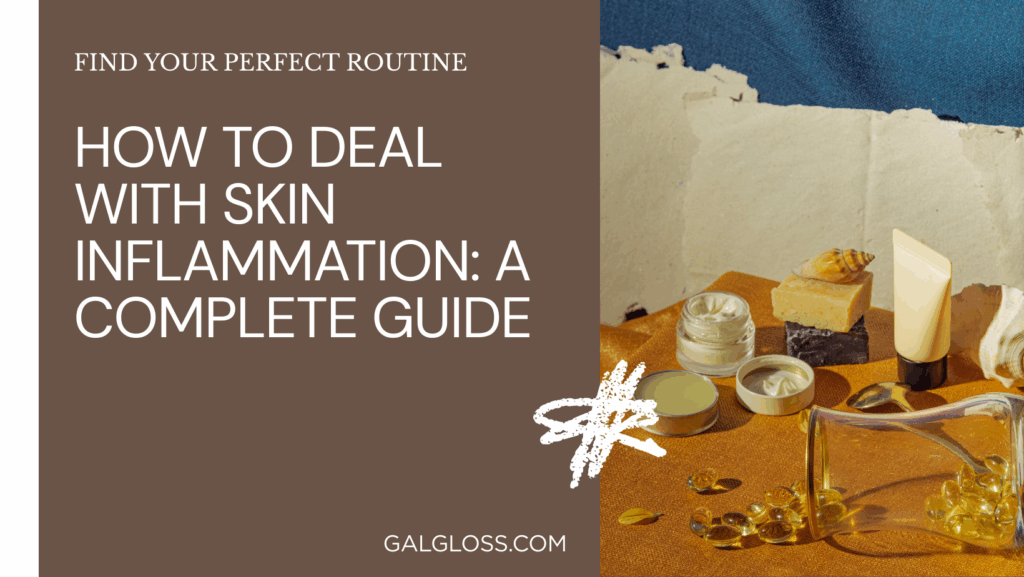Ever felt like your skin’s throwing a tantrum? Red, itchy, and downright uncomfortable? You’re not alone. Skin inflammation is like that uninvited guest at a party – annoying and hard to get rid of. But don’t worry, we’ve got your back!
In this guide, we’ll dive deep into the world of skin inflammation. We’ll explore what causes it, how to spot it, and most importantly, how to kick it to the curb. Whether you’re dealing with a minor irritation or a full-blown flare-up, we’ve got tips and tricks that’ll have your skin singing your praises in no time.
So, why should you care about skin inflammation? Well, besides the obvious discomfort, it can be a sign that something’s not quite right in your body. It might be telling you to switch up your skincare routine, rethink your diet, or even check in with a doc. Plus, let’s face it – when our skin’s happy, we feel more confident and ready to take on the world.
Ready to become a skin whisperer? Let’s roll up our sleeves and get started on your journey to calmer, happier skin!
Understanding Skin Inflammation

First things first – what exactly is skin inflammation? Think of it as your skin’s SOS signal. When something’s not right, your skin cells call for backup, and your body responds by sending blood and immune cells to the area. This can lead to redness, swelling, and that oh-so-annoying itch.
But not all inflammation is created equal. Here are some common types you might encounter:
- Dermatitis: A catch-all term for skin irritation
- Eczema: Dry, itchy patches that can appear anywhere on the body
- Psoriasis: Thick, scaly patches often found on elbows, knees, and scalp
- Rosacea: Redness and visible blood vessels, usually on the face
- Acne: Those pesky pimples we all know and loathe
How do you know if you’re dealing with inflammation? Keep an eye out for these symptoms:
- Redness
- Swelling
- Itching or burning sensation
- Warmth in the affected area
- Pain or tenderness
- Changes in skin texture
Remember, your skin is unique, so your symptoms might not look exactly like someone else’s. When in doubt, it’s always best to consult a dermatologist.
Common Triggers of Skin Inflammation
Now that we know what skin inflammation looks like, let’s talk about what causes it. Spoiler alert: it’s not always just one thing. Here are some common culprits:
Environmental Factors
- Sun exposure: Too much sun can lead to inflammation and damage
- Weather changes: Extreme cold or heat can irritate your skin
- Pollution: City dwellers, take note – air pollution can wreak havoc on your skin
- Allergens: Pollen, dust, and pet dander can all trigger inflammation
Diet and Nutrition
What you put in your body can show up on your skin. Some foods that might cause inflammation include:
- Processed foods
- Sugar
- Dairy (for some people)
- Gluten (if you’re sensitive)
On the flip side, an anti-inflammatory diet rich in fruits, vegetables, and omega-3 fatty acids can help calm your skin.
Stress and Lifestyle
Ever noticed your skin acts up when you’re stressed? You’re not imagining it. Stress can trigger inflammation and exacerbate existing skin conditions. Other lifestyle factors that can play a role include:
- Lack of sleep
- Smoking
- Excessive alcohol consumption
- Not drinking enough water
Natural Remedies for Skin Inflammation
Now for the good stuff – how to deal with skin inflammation naturally. While these remedies won’t work for everyone, they’re worth a try:
Dietary Changes
- Load up on antioxidant-rich foods like berries, leafy greens, and nuts
- Incorporate anti-inflammatory spices like turmeric and ginger into your meals
- Try probiotics to support gut health (which is linked to skin health)
- Stay hydrated – aim for at least 8 glasses of water a day
Herbal Treatments
Nature’s got some pretty powerful anti-inflammatory agents. Consider trying:
- Aloe vera: Soothing and cooling for irritated skin
- Chamomile: Can help calm redness and itching
- Calendula: Known for its healing properties
- Green tea: Rich in antioxidants that can help fight inflammation
Essential Oils
Essential oils can be a game-changer for inflamed skin. Just remember to always dilute them with a carrier oil before applying to your skin. Some to try:
- Lavender oil: Calming and soothing
- Tea tree oil: Great for acne-prone skin
- Frankincense oil: Can help reduce the appearance of scars and fine lines
Medical Treatments
Sometimes, natural remedies just don’t cut it. That’s where medical treatments come in:
Over-the-Counter Options
- Hydrocortisone cream: For mild inflammation and itching
- Antihistamines: Can help with allergic reactions
- Salicylic acid or benzoyl peroxide: For acne-related inflammation
Prescription Medications
For more severe cases, your doctor might prescribe:
- Topical corticosteroids: Stronger than over-the-counter options
- Oral medications: For widespread or severe inflammation
- Biologics: For conditions like psoriasis
Remember, always consult with a healthcare professional before starting any new medication.
Lifestyle Changes to Reduce Inflammation
Dealing with skin inflammation isn’t just about what you put on your skin – it’s about your overall lifestyle. Here are some changes that can make a big difference:
Stress Management Techniques
Stress and skin inflammation often go hand in hand. Try these techniques to keep stress at bay:
- Meditation: Even just 10 minutes a day can help
- Deep breathing exercises: Great for quick stress relief
- Yoga: Combines physical activity with mindfulness
Exercise and Its Benefits
Getting your sweat on isn’t just good for your waistline – it’s great for your skin too! Exercise:
- Increases blood flow, delivering nutrients to your skin
- Helps reduce stress
- Can improve sleep quality
Aim for at least 30 minutes of moderate exercise most days of the week.
Sleep and Skin Health
They don’t call it beauty sleep for nothing! Poor sleep can lead to increased inflammation throughout your body, including your skin. Aim for 7-9 hours of quality sleep each night. Some tips for better sleep:
- Stick to a consistent sleep schedule
- Create a relaxing bedtime routine
- Keep your bedroom cool and dark
- Avoid screens for at least an hour before bed
Prevention Strategies
As the saying goes, an ounce of prevention is worth a pound of cure. Here’s how to keep skin inflammation at bay:
Daily Skincare Routine
- Cleanse gently: Use a mild, fragrance-free cleanser
- Moisturize: Look for products with ceramides or hyaluronic acid
- Exfoliate (but not too much): Once or twice a week is usually enough
- Use products suited to your skin type: What works for your friend might not work for you
Sun Protection
Sun damage is a major cause of skin inflammation. Protect your skin by:
- Using a broad-spectrum sunscreen with at least SPF 30
- Wearing protective clothing and hats
- Seeking shade, especially during peak sun hours
Avoiding Irritants
Pay attention to what triggers your skin inflammation and avoid those triggers when possible. Common irritants include:
- Harsh soaps and detergents
- Certain fabrics (like wool for some people)
- Fragrances in skincare products
- Hot water (lukewarm is better for your skin)
When to Seek Professional Help
While many cases of skin inflammation can be managed at home, sometimes it’s best to call in the pros. Here are some signs it’s time to see a dermatologist:
- Your symptoms are severe or getting worse
- Home remedies aren’t helping
- You’re not sure what’s causing your inflammation
- Your skin inflammation is affecting your quality of life
When choosing a specialist, look for a board-certified dermatologist with experience treating your specific condition. Don’t be afraid to ask questions and shop around until you find a doctor you’re comfortable with.
At your appointment, be prepared to discuss:
- Your symptoms and when they started
- Any triggers you’ve identified
- Treatments you’ve already tried
- Your medical history and any medications you’re taking
Remember, your dermatologist is there to help. Be honest and open about your concerns and goals for treatment.
Conclusion
Dealing with skin inflammation can feel like a never-ending battle, but armed with the right knowledge and tools, you can take control of your skin health. Remember, everyone’s skin is different, so what works for one person might not work for another. Be patient with yourself and your skin as you figure out what works best for you.
Here’s a quick recap of our key points:
- Understand your skin inflammation: Know the types and symptoms
- Identify your triggers: Environmental factors, diet, and stress all play a role
- Try natural remedies: Dietary changes, herbal treatments, and essential oils can help
- Consider medical treatments when necessary
- Make lifestyle changes: Manage stress, exercise, and prioritize sleep
- Prevention is key: Develop a good skincare routine and protect your skin from the sun
- Know when to seek professional help
Remember, your skin is your body’s largest organ – it deserves some TLC! By taking steps to reduce inflammation, you’re not just improving the look and feel of your skin – you’re supporting your overall health and well-being.
So, are you ready to show your skin some love? Start small, be consistent, and don’t be afraid to ask for help when you need it. Your future self (and your skin) will thank you!





